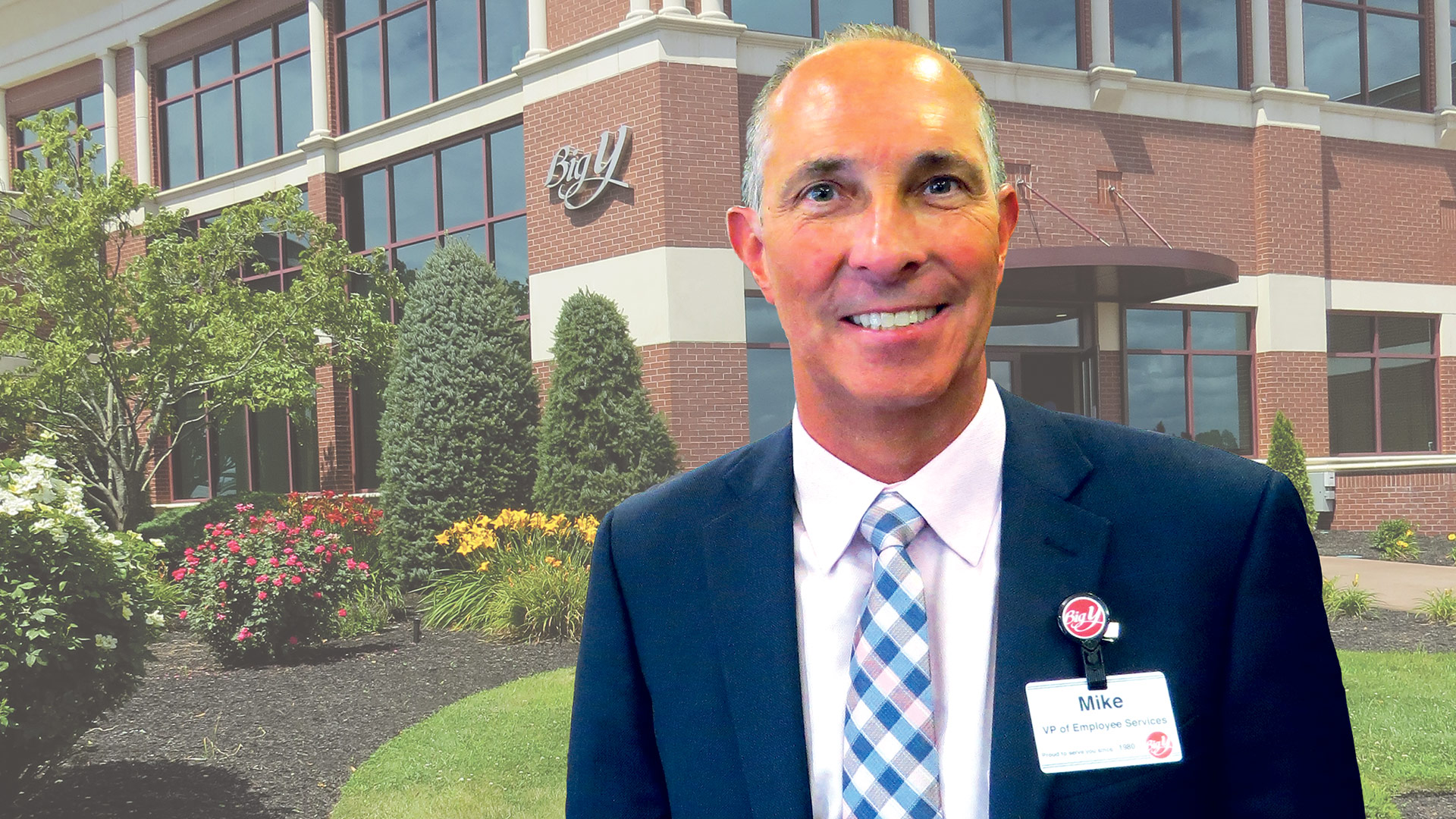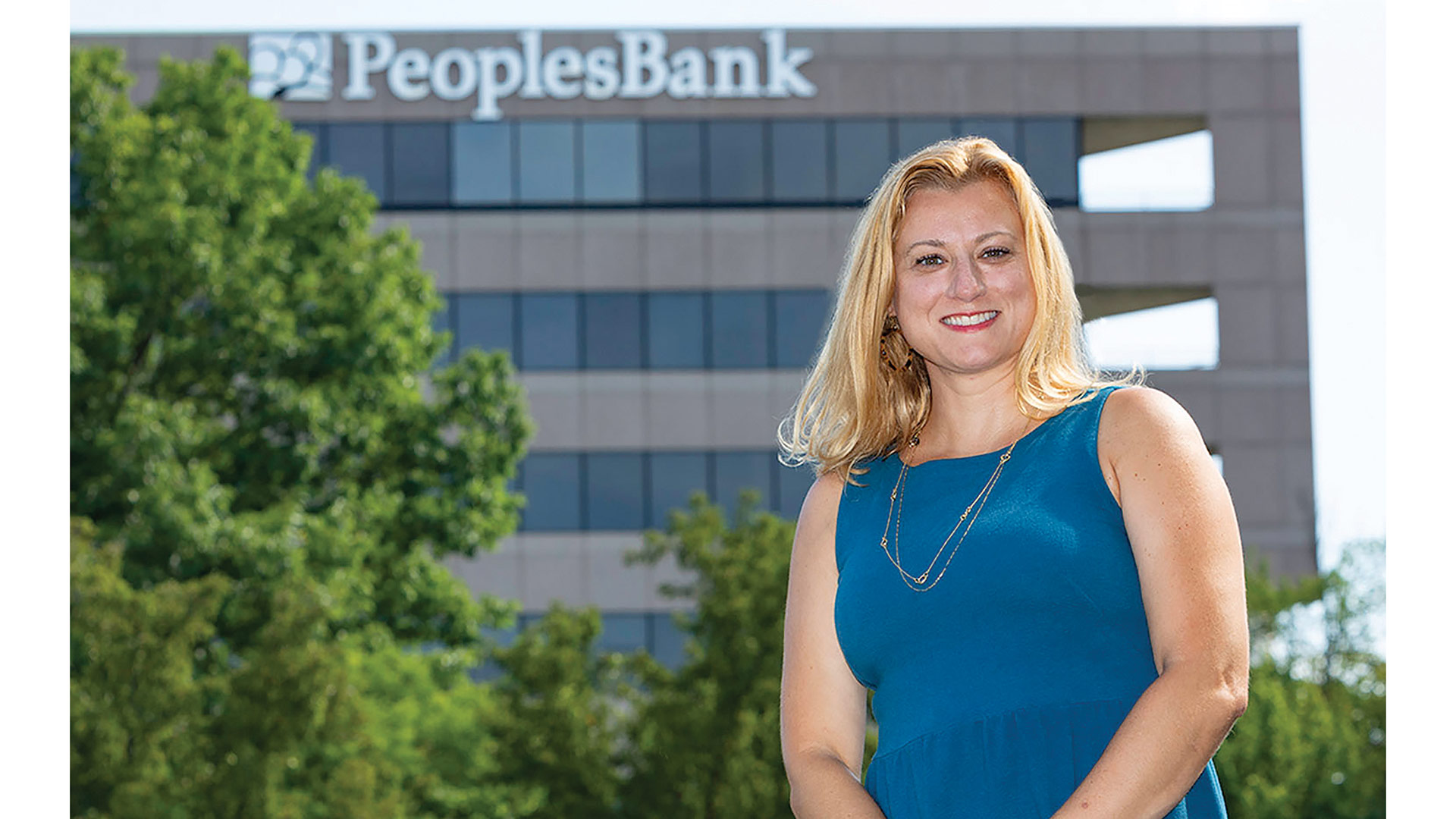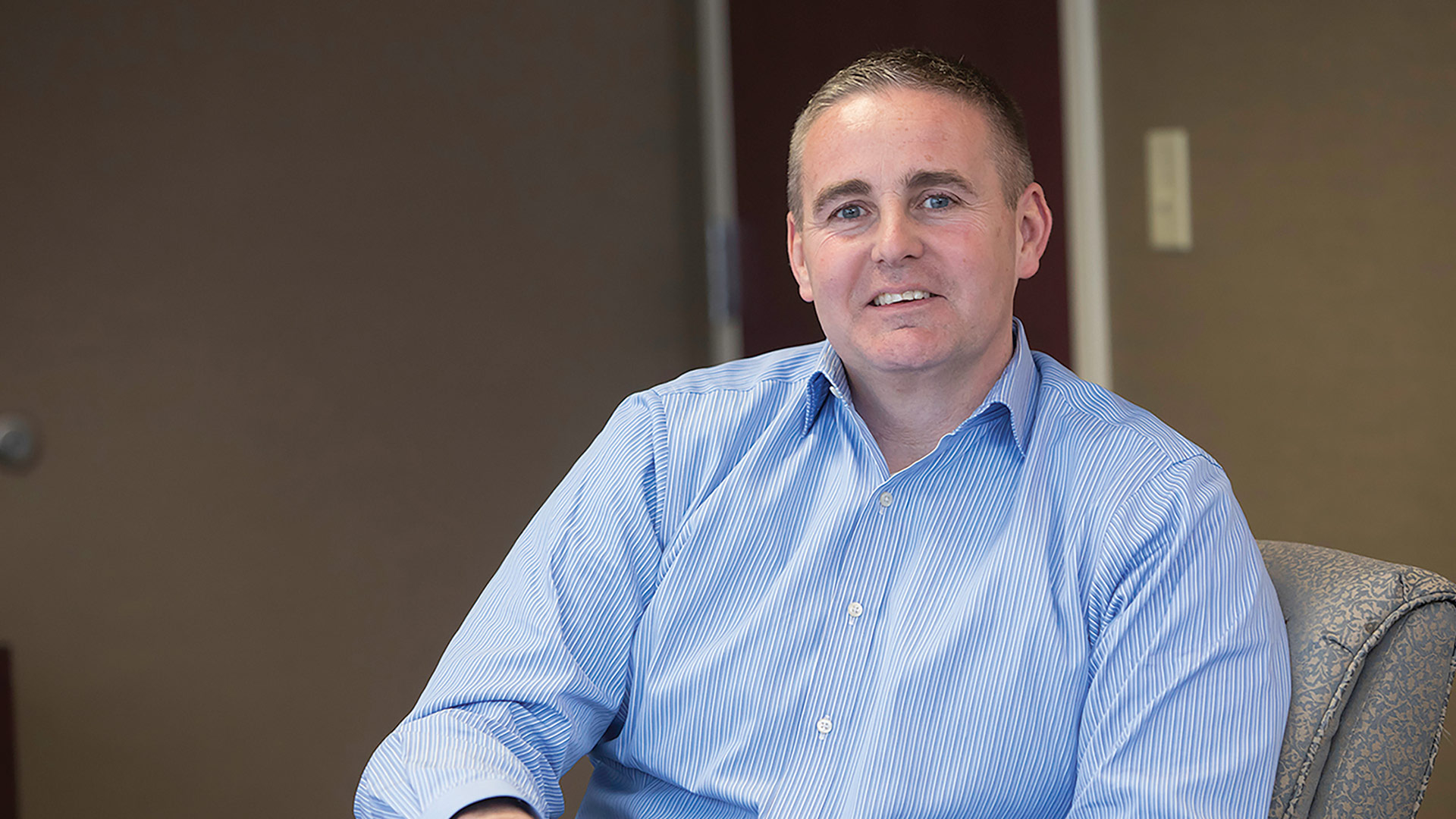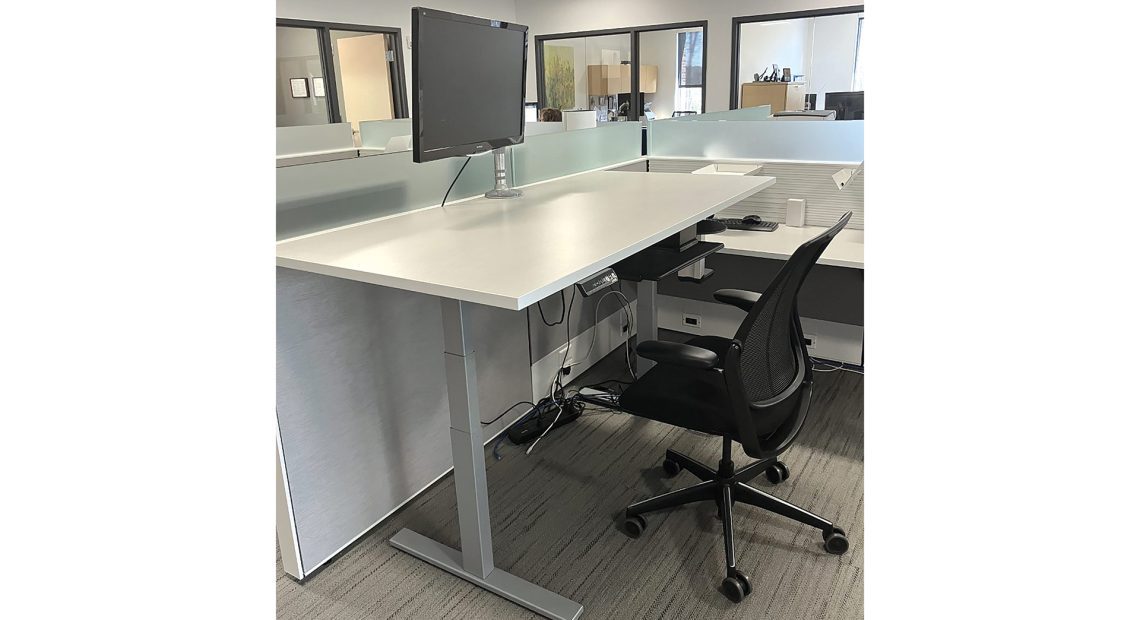The Future of Work

Michael Galat, vice president of Employee Services at Big Y.
When businesses sent employees home in mid-March, many thought it would be for just a few weeks. Instead, as the pandemic lingered, weeks stretched into months, and now, even as companies are allowed to bring their teams back on site, many have not. The reason? Employers say it makes little sense to risk their people’s health if they can do their job just as well at home. But … if they can work effectively at home, why bring them back at all? That’s a conversation many companies are having as they ponder the future of the workplace in the COVID-19 era.
Big Y Foods is one of the region’s largest companies, with more than 11,000 employees throughout Massachusetts and Connecticut. It has also been an essential business throughout the pandemic, so it never shut down.
Many of its employees — those who stock shelves, prepare food, work the cashier lines, and do any number of other tasks — must do their jobs on site, in a specific location. But at Big Y’s 300-employee-strong customer-support center in Springfield, which supports those frontline workers, that wasn’t necessarily the case.
“About 80% of them started working from home once COVID-19 started gaining traction,” said Michael Galat, vice president of Employee Services at Big Y. That shift meant setting everyone up with the right equipment if they didn’t have it at home, and also putting together a best-practices guide for working remotely. “Whether people are working remotely or not, they need to have access and be available to support those locations.”
The lesson learned over four months? They did their jobs just fine. And until COVID-19 begins to subside in earnest, Big Y is taking its time bringing employees — at least the ones who don’t have to work in the stores — back to their pre-pandemic workspaces.
“We’re definitely taking our time. We’re at about 30% in the support center now,” Galat said. “Obviously this is peak vacation time, but we are slowly, and I mean slowly, reintegrating people in the support center.”
PeoplesBank is learning similar lessons about what employees can accomplish at home, said Amy Roberts, chief Human Resources officer.
“There’s always a concern, when you don’t have someone on site, because you can’t see what they’re doing. Are they working?” she said. “But we haven’t really missed a beat in terms of productivity levels. Some people like working from home — it works for them — while some people prefer working in the office, and they can’t wait to come back. But for overall productivity and meeting the needs of customers, we haven’t had any concerns.”
Roberts doesn’t see a day, post-pandemic, when the majority of bank employees are still working at home. But functioning so well over the past few months has at least gotten HR leaders talking.
“Is this something we can do on a more permanent basis? We’re still trying to figure out the right blend. But there seems to be some opportunity for flexible work options, and I think we’re going to do that in the future.”
“Is this something we can do on a more permanent basis? We’re still trying to figure out the right blend,” she told BusinessWest. “But there seems to be some opportunity for flexible work options, and I think we’re going to do that in the future.”
Patrick Leary has had those conversations, too. As a partner with MP CPAs, he understands that much of his business is face to face with clients. “But I don’t think we’ll go back to 100% on site.”
Elaborating, he explained that “the model of having everyone show up at 9 o’clock and work all day until 5, then go home, I think it’s really been proven that it doesn’t need to be that way. Yes, we need to have people available, and we can’t have somebody that decides, ‘I want to enjoy my day, so I’ll start the workday at 5 p.m. and work till 1 a.m.’ — although some of the 20-somethings might like that; me, I need to be in bed by 9.”
But while it’s true that employees need to be available to field phone calls and take appointments during core work hours, he went on, it may not be necessary to have everyone working in the same place at the same time.
“I think our ideas about what is a regular workplace have completely changed,” Leary went on, and it wasn’t sending everyone home in March that shifted those ideas; it was how long the stay-at-home trend has lasted.

Amy Roberts says PeoplesBank has to balance the benefits of working at home with the interactive employee culture it has cultivated.
“If everyone went home, and two weeks later they were back in the office, we wouldn’t be having this conversation,” he noted. “But we’ve proven in four months that people can work at home, work efficiently at home, and accept working at home.”
These three companies — a supermarket chain, a bank, and an accounting firm — all have totally different business models and customer needs, yet they’re all saying the same thing when it comes to the workplace of the future, and specifically whether remote work is here to stay: nothing is set in stone, but it’s a conversation worth having.
Shifting on the Fly
Shifting to remote appointments back in March was a smooth process, Leary said, partly because all the clients were working remotely, too.
“That part of it was not overly challenging,” he added. “And we had stress-tested our internal systems about a month earlier as good practice, just to see how we were doing. We did some modifications, so system-wide, we were in good shape. We had been using voice over internet for the phones, so when someone called at the office, it could ring at the house. So we were good there.”
The company did need to work through some quality-control issues, however, especially since the team was being physically separated during the heart of tax-preparation season.
“That, to me, was the biggest challenge,” he said. “Most people are accustomed to doing that in face-to-face settings, but we did it with everyone at home. We developed some protocols for how that would work.”
The firm created a schedule for individuals to come to the office to pick up packages, scan documents, and send them to the right people.
“The model of having everyone show up at 9 o’clock and work all day until 5, then go home, I think it’s really been proven that it doesn’t need to be that way.”
“Then there was the whole PPP thing, working with virtually all our business clients, showing them how to apply for it, and making sure they knew they rules, which were evolving almost daily,” Leary recalled. “We had a core group staying really closely involved and on top of the regulations, and we did a couple of webinars for clients.”
Then there was COVID-19 itself. “We were helping clients through their issues with business being called off — what do they do for cash flow?” he went on. “But the biggest challenge for me was that it all occurred during our busiest time.”
Banking customers were dealing with some of the same issues, as well as their usual needs, and PeoplesBank leaders were quick to make sure employees were set up to work at home.
“In a matter of two weeks, we assigned something like 150 Chromebooks and issued VPN access to all office items,” Roberts said, noting that about 170 people who work in the office were sent home to work. Some, who could not get the access they needed for whatever reason, were paid until the issues were resolved, and they began working from home as well.
These days, the main office is about 25% occupied, with most still working totally from home and others coming into the office one or two days a week. Like Leary, Roberts said discussions have already taken place regarding what the past four months mean for the future of remote work.
“There are definitely limitations, if we’re going to pursue it is a work type,” she said. “We’re going to need technology that ensures full access and takes care of the little things you experience when you’re at home instead of the office, like system slowdowns and delays.”
In short, if PeoplesBank is going to expand remote work in perpetuity — and not just because a pandemic has forced much of the work world home — it needs to the same experience from a work standpoint. “We’ve highlighted things that can be better. But for the most part, it’s been pretty seamless.”
Leary said the current situation has opened his eyes to internet infrastructure needs in the community, especially in places like the hilltowns, which can run into slow speeds and spotty cell service. “If this becomes the new norm, we can’t have someone working in their house who can’t connect to the outside world efficiently.”
Remote Learning
For a company like Big Y — which, between its supermarkets, convenience stores, and gas stations, is a 24/7 operation — flexible work options on the customer-support side make sense, Galat said.
“We’re able to give flexibility to that employee who may have childcare issues, or is caring for an elderly parent, and it allows us to support our stores while minimizing the amount of people who come in here,” he said, which remains an issue with the pandemic still a threat. “So having flexibility of schedule helps their personal lives and also our workplace.”

Patrick Leary says a shift to more permanent work-at-home options will require an investment in technology.
Claire D’Amour-Daley, the chain’s vice president of Corporate Communications, agreed. “Some have even felt more productive at home than here. It will certainly be part of the workplace of the future.”
She was especially impressed that the company was able to shift how it did business — not just moving some employees home, but taking steps to protect the ones in the stores — essentially on the fly.
“We’re used to working quickly, but not that quickly,” she said. “The stores were slammed the first few weeks, and this added yet another element of urgency. But we never stopped; we quickly pivoted to serve our stores and our customers in an unprecedented manner.”
“We made it work, and we needed to,” Galat added. “We needed to stay connected more than ever during this time.”
That said, “there are more discussions to be had,” he continued. “Absolutely, some lessons were learned — we’re able to support our locations — but when you look at the company-culture part of it, you lose that social aspect.”
To counter that, remote employees have been conferencing over Zoom three or four times a week, in some departments every day. Meanwhile, they’ve been issued guidance for working efficiently at home, from creating a comfortable, ergonomically correct work area to setting aside time for mind-clearing breaks.
“Eighty to 85% of the feedback has been positive,” Galat said. “People have been able to get their products done. Some have missed the social element, but for others, there’s value in the time saved not commuting in traffic.”
PeoplesBank has long promoted an interactive, employee-centric culture, and that has to be considered when pondering the future of the workplace.
“We rely on that interaction and engagement you get by being in the office together as a group,” Roberts said.
“Making sure we can continue that interactive part of our culture is something I’m really focused on right now. That’s a tricky one. If you have a completely remote workforce, you lose some of those engagement opportunities, and you have to shift some of the ways you engage. We’re not going to let that stop us from pursuing flexibility, but we have to consider the great culture that we have.”
Home or Away?
While employee culture and technology requirements are certainly legitimate topics of discussion, none of the professionals who spoke with BusinessWest expressed much concern about employee accountability and efficiency — “our concerns about people not doing their work dissipated pretty quickly,” D’Amour-Daley said — meaning remote workers may indeed have a broader role in the future.
“It’s been interesting to say the least,” Leary said. “I’ve fallen into a pretty good routine from day one. I’ve tried to make it a regular day: shower, get dressed — not in a suit, but not pajamas — and sit down at my computer. It makes for a more normal routine than saying, ‘I’ll get to work when I get to it.’ And I think most people would feel the same.”
Expanded use of remote work would also open up opportunities for both companies and employees, especially those who want to live in, say, Boston or New York City, he noted. Those individuals could expand their job-search horizons, while Western Mass. could become a more attractive place for businesses to set down roots, taking advantage of the region’s relatively low lease rates while hiring from afar.
All these opportunities can only open up if remote work proves a viable option. And companies of all types are starting to think it is.
“I haven’t had a single client call and say, ‘hey, I was talking to Sally, and I heard a dog barking in the background; it was really distracting,’” Leary said. “I actually think the idea of working from home is good for people. In that time they’d be commuting, maybe they’re exercising or spending more time with their family.
“People do miss the social interaction,” he was quick to add. “Maybe they live alone, or it’s just them and their significant other in the office.”
But the employees of MP CPAs who are back in the office — about half the team — are there by choice, he said, with others choosing to remain at home.
Because it works. And employers like things that work. So, in this era of Zoom and home offices and (sometimes) pajamas, they’re paying attention.
Joseph Bednar can be reached at [email protected]










